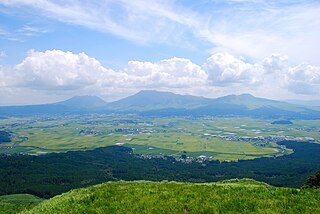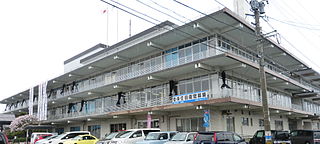Amakusa Airlines Co., Ltd. is an airline based in Amakusa, Kumamoto Prefecture, Japan. It operates regional services from and to Amakusa. Its main base is Amakusa Airfield, with a focus city in Kumamoto Airport.

Cerrejón is a large open-pit coal mine in Colombia. It is located in the southeast of the department of La Guajira, close to the border with Venezuela. The coal mine is situated in the northeastern part of the Cesar-Ranchería Basin, the basin of the Ranchería River, between the Sierra Nevada de Santa Marta in the west and the Serranía del Perijá to the southeast. At Cerrejón, low-ash, low-sulphur bituminous coal from the Cerrejón Formation is excavated. The mine is one of the largest of its type, the largest in Latin America and the tenth biggest in the world. Cerrejón extends over 690 square kilometres (270 sq mi). It is divided into three sections, North Zone, Central Zone and South Zone. Total proven reserves are estimated at 503 megatonnes. In 2016, the mine produced 32,683,315 tonnes.

The Wonthaggi railway line is a closed railway line located in South Gippsland, Victoria, Australia. Its primary purpose was to serve the State Coal Mine but the line also provided passenger and general goods services. The line was opened in 1910 and closed in 1978.

The Somerset Coalfield in northern Somerset, England is an area where coal was mined from the 15th century until 1973. It is part of a larger coalfield which stretched into southern Gloucestershire. The Somerset coalfield stretched from Cromhall in the north to the Mendip Hills in the south, and from Bath in the east to Nailsea in the west, a total area of about 240 square miles (622 km2). Most of the pits on the coalfield were concentrated in the Cam Brook, Wellow Brook and Nettlebridge Valleys and around Radstock and Farrington Gurney. The pits were grouped geographically, with clusters of pits close together working the same coal seams often under the same ownership. Many pits shared the trackways and tramways which connected them to the Somerset Coal Canal or railways for distribution.
The South Yorkshire Coalfield is so named from its position within Yorkshire. It covers most of South Yorkshire, West Yorkshire and a small part of North Yorkshire. The exposed coalfield outcrops in the Pennine foothills and dips under Permian rocks in the east. Its most famous coal seam is the Barnsley Bed. Coal has been mined from shallow seams and outcrops since medieval times and possibly earlier.
The technological and industrial history of China is extremely varied, and extensive. China's industrial sector has shown great progress using most of its technology from the 1950s.

F60 is the series designation of five overburden conveyor bridges used in brown coal (lignite) opencast mining in the Lusatian coalfields in Germany. They were built by the former Volkseigener Betrieb TAKRAF in Lauchhammer and are the largest movable technical industrial machines in the world. As overburden conveyor bridges, they transport the overburden which lies over the coal seam. The cutting height is 60 m (200 ft), hence the name F60. With a length of 502 m (1,647 ft), it is described as the lying Eiffel tower. In total, the F60 is up to 80 m (260 ft) high and 240 m (790 ft) wide. In operating condition, it weighs 13,600 metric tons. The first conveyor bridge was built from 1969 to 1972, being equipped with a feeder bridge in 1977. The second was built from 1972 to 1974, having been equipped with a feeder bridge during construction. The third conveyor bridge was built from 1976 to 1978, being provided with a feeder bridge in 1985. The fourth and fifth conveyor bridges were built 1986–1988 and 1988–1991 respectively.
The mineral industry of Mozambique plays a significant role in the world’s production of aluminium, beryllium, and tantalum. In 2006, Mozambique's share of the world's tantalum mine output amounted to 6%; beryllium, 5%; and aluminium, 2%. Other domestically significant mineral processing operations included cement and natural gas.
Coal mining in India began in 1774 when John Sumner and Suetonius Grant Heatly of the East India Company commenced commercial exploitation in the Raniganj Coalfield along the Western bank of Damodar river. Growth remained slow for nearly a century due to low demand. The introduction of steam locomotives in 1853 boosted demand, and coal production rose to an annual average of 1 million metric tons. India produced 6.12 million metric tons of coal per year by 1900 and 18 million metric tons per year by 1920. Coal production rose steadily over the next few decades, and was boosted by demand caused by World War I. Production slumped in the interwar period, but rose to 30 million metric tons by 1946 largely as a result of World War II.

The North Staffordshire Coalfield was a coalfield in Staffordshire, England, with an area of nearly 100 square miles (260 km2), virtually all of it within the city of Stoke on Trent and the borough of Newcastle-under-Lyme, apart from three smaller coalfields, Shaffalong and Goldsitch Moss Coalfields near Leek and the Cheadle Coalfield. Coal mining in North Staffordshire began early in the 13th century, but the industry grew during the Industrial Revolution when coal mined in North Staffordshire was used in the local Potteries ceramics and iron industry.

Amakusa Airfield (天草飛行場) is an airport located 2.3 NM northwest of Amakusa, Kumamoto, Japan, on the Amakusa Islands. Locals often referred to the airfield as Amakusa Airport. It is located on the northern side of the Amakusa Islands, north west of Amakusa city. Only one airline, Amakusa Airlines, uses this airfield.

Five Bridges of Amakusa are five road bridges at the south tip of Japan, linking the Kyushu mainland and the Amakusa Islands. The bridges connect to the islands of Ōyano-jima, Nagaura-jima, Ike-jima, and Maeshima, and were completed on September 24, 1966. The Five Bridges gave hope and confidence in the development of Japan's bridge-construction technology, and changed the lives of those living at the Amakusa Islands. Many tourists come to view the scenic beauty of the many islands, and the roads are called the Amakusa Pearl Line, based on the products of cultured pearls.

The Lancashire Coalfield in North West England was one of the most important British coalfields. Its coal seams were formed from the vegetation of tropical swampy forests in the Carboniferous period over 300 million years ago.
The Thar coalfield is located in Thar Desert, Tharparkar District of Sindh province in Pakistan. The deposits—16th-largest coal reserves in the world, were discovered in 1991 by Geological Survey of Pakistan (GSP) and the United States Agency for International Development.

The history of Kumamoto Prefecture has been documented from paleolithic times to the present. Kumamoto Prefecture is the eastern half of Hinokuni, and corresponds to what was once called Higo Province. Exceptions are the part of Kuma District, which had once been part of Sagara Domain, and Nagashima which was included in Kagoshima Prefecture.

The Minden Coalfield is located in the northern Wiehen foothills near the German town of Minden. Here, seams of Wealden Coal (Wealdenkohle) reach the surface of the earth in the Schaumburg Basin. During the Thirty Years' War Swedish soldiers first discovered this black coal near Minden whilst preparing fieldworks on the Bölhorst. By 1663 it was forbidden to dig privately for coal and severe penalties were imposed for doing so.

Bradford Colliery was a coal mine in Bradford, Manchester, England. Although part of the Manchester Coalfield, the seams of the Bradford Coalfield correspond more closely to those of the Oldham Coalfield. The Bradford Coalfield is crossed by a number of fault lines, principally the Bradford Fault, which was reactivated by mining activity in the mid-1960s.
Some of the more notable coal companies in Australia are the following:

The coal industry in Wales has played an important role in the Industrial Revolution in Wales. Coal mining expanded in the eighteenth century to provide fuel for the blast furnaces of the iron and copper industries that were expanding in southern Wales. The industry had reached large proportions by the end of that century, and then further expanded to supply steam-coal for the steam vessels that were beginning to trade around the world. The Cardiff Coal Exchange set the world price for steam-coal and Cardiff became a major coal-exporting port. The South Wales Coalfield was at its peak in 1913 and was one of the largest coalfields in the world. It remained the largest coalfield in Britain until 1925. The supply of coal dwindled, and pits closed in spite of a UK-wide strike against closures. The last deep mine in Wales, Tower Colliery, closed in 2008, after thirteen years as a co-operative owned by its miners.















